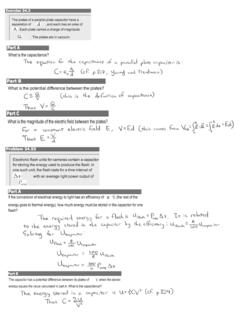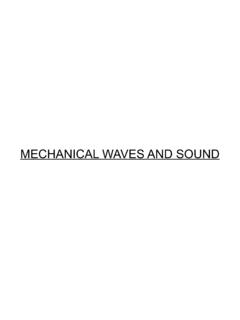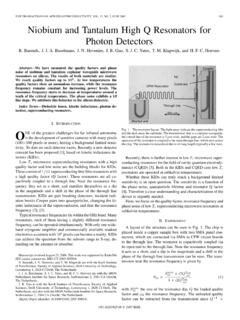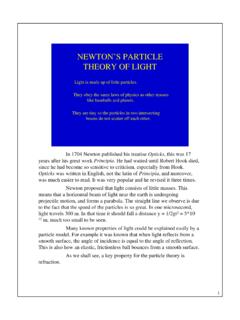Transcription of Quantum Field Theory
1 Quantum Field TheoryMark SrednickiUniversity of California, Santa 2006 by M. SrednickiAll rights DO NOT DISTRIBUTE this , link my parentsCasimir and Helen Srednickiwith gratitudeContentsPreface for Students8 Preface for Instructors12 Acknowledgments16I Spin Zero181 Attempts at relativistic Quantum mechanics192 Lorentz Invariance (prerequisite: 1)303 Canonical Quantization of Scalar Fields (2)364 The Spin-Statistics Theorem (3)455 The LSZ Reduction Formula (3)496 Path Integrals in Quantum Mechanics577 The Path Integral for the Harmonic Oscillator (6)638 The Path Integral for Free Field Theory (3, 7)679 The Path Integral for Interacting Field Theory (8)7110 Scattering Amplitudes and the Feynman Rules (5, 9)8711 Cross Sections and Decay Rates (10)9312 Dimensional Analysis with h=c= 1(3)10413 The Lehmann-K all en Form of the Exact Propagator (9) 10614 Loop Corrections to the Propagator (10, 12, 13)10915 The One-Loop Correction in Lehmann-K all en Form (14) 12016 Loop Corrections to the Vertex (14)12417 Other 1PI Vertices (16)12718 Higher-Order Corrections and Renormalizability (17)129419 Perturbation Theory to All Orders (18)
2 13320 Two-Particle Elastic Scattering at One Loop (19)13521 The Quantum Action (19)13922 Continuous Symmetries and Conserved Currents (8)14423 Discrete Symmetries:P,T,C, andZ(22)15224 Nonabelian Symmetries (22)15725 Unstable Particles and Resonances (14)16126 Infrared Divergences (20)16727 Other Renormalization Schemes (26)17228 The Renormalization Group (27)17829 Effective Field Theory (28)18530 Spontaneous Symmetry Breaking (21)19631 Broken Symmetry and Loop Corrections (30)20032 Spontaneous Breaking of Continuous Symmetries (22, 30)205II Spin One Half21033 Representations of the Lorentz Group (2)21134 Left- and Right-Handed Spinor Fields (3, 33)21535 Manipulating Spinor Indices (34)22236 Lagrangians for Spinor Fields (22, 35)22637 Canonical Quantization of Spinor Fields I (36)23638 Spinor Technology (37)24039 Canonical Quantization of Spinor Fields II (38)24640 Parity, Time Reversal, and Charge Conjugation (23, 39) 254541 LSZ Reduction for Spin-One-Half Particles (5, 39)
3 26342 The Free Fermion Propagator (39)26843 The Path Integral for Fermion Fields (9, 42)27244 Formal Development of Fermionic Path Integrals (43) 27645 The Feynman Rules for Dirac Fields (10, 12, 41, 43)28246 Spin Sums (45)29247 Gamma Matrix Technology (36)29548 Spin-Averaged Cross Sections (46, 47)29849 The Feynman Rules for Majorana Fields (45)30350 Massless Particles and Spinor Helicity (48)30851 Loop Corrections in Yukawa Theory (19, 40, 48)31452 Beta Functions in Yukawa Theory (28, 51)32353 Functional Determinants (44, 45)326 III Spin One33154 Maxwell s Equations (3)33255 Electrodynamics in Coulomb Gauge (54)33556 LSZ Reduction for Photons (5, 55)33957 The Path Integral for Photons (8, 56)34358 Spinor Electrodynamics (45, 57)34559 Scattering in Spinor Electrodynamics (48, 58)35160 Spinor Helicity for Spinor Electrodynamics (50, 59)35661 Scalar Electrodynamics (58)36462 Loop Corrections in Spinor Electrodynamics (51, 59)369663 The Vertex Function in Spinor Electrodynamics (62)37864 The Magnetic Moment of the Electron (63)38365 Loop Corrections in Scalar Electrodynamics (61, 62)38666 Beta Functions in Quantum Electrodynamics (52, 62) 39567 Ward Identities in Quantum Electrodynamics I (22, 59) 39968 Ward Identities in Quantum Electrodynamics II (63, 67) 40369 Nonabelian Gauge Theory (24, 58)40770 Group Representations (69)41271 The Path Integral for Nonabelian Gauge Theory (53, 69) 42072 The Feynman Rules for Nonabelian Gauge Theory (71) 42473 The Beta Function in Nonabelian Gauge Theory (70, 72) 42774 BRST Symmetry (70, 71)43575 Chiral Gauge Theories and Anomalies (70, 72)
4 44376 Anomalies in Global Symmetries (75)45577 Anomalies and the Path Integral for Fermions (76)45978 Background Field Gauge (73)46579 Gervais Neveu Gauge (78)47380 The Feynman Rules forN NMatrix Fields (10)47681 Scattering in Quantum Chromodynamics (60, 79, 80)48282 Wilson Loops, Lattice Theory , and Confinement (29, 73) 49483 Chiral Symmetry Breaking (76, 82)50284 Spontaneous Breaking of Gauge Symmetries (32, 70)51285 Spontaneously Broken Abelian Gauge Theory (61, 84) 517786 Spontaneously Broken Nonabelian Gauge Theory (85) 52387 The Standard model : Gauge and Higgs Sector (84)52788 The Standard model : Lepton Sector (75, 87)53289 The Standard model : Quark Sector (88)54090 Electroweak Interactions of Hadrons (83, 89)54691 Neutrino Masses (89)55592 Solitons and Monopoles (84)55893 Instantons and Theta Vacua (92)57194 Quarks and Theta Vacua (77, 83, 93)58295 Supersymmetry (69)59096 The Minimal Supersymmetric Standard model (89, 95) 60297 Grand Unification (89)605 Bibliography6158 Preface for StudentsQuantum Field theoryis the basic mathematical language that is used todescribe and analyze the physics of elementary particles.
5 The goal of thisbook is to provide a concise, step-by-step introduction to this subject, onethat covers all the key concepts that are needed to understand the StandardModel of elementary particles, and some of its proposed order to be prepared to undertake the study of Quantum fieldtheory,you should recognize and understand the following equations:d d =|f( , )|2a |ni= n+1|n+1iJ |j,mi= j(j+1) m(m 1)|j,m 1iA(t) =e+iHt/ hAe iHt/ hH=p q Lct = (ct x)E= (p2c2+m2c4)1/2E= A/c This list is not, of course, complete; but if you are familiarwith theseequations, you probably know enough about Quantum mechanics, classicalmechanics, special relativity, and electromagnetism to tackle the materialin this Field Theory has a reputation as a subject that is hardtolearn. The problem, I think, is not so much that its basic ingredients areunusually difficult to master (indeed, the conceptual shift needed to gofrom Quantum mechanics to Quantum Field Theory is not nearly as severeas the one needed to go from classical mechanics to Quantum mechanics),but rather that there are alotof these ingredients.
6 Some are fundamental,but many are just technical aspects of an unfamiliar form of this book, I have tried to make the subject as accessible tobeginnersas possible. There are three main aspects to my development of the basic is, of course, very differ-ent from the historical development of Quantum Field Theory ,which, like thehistorical development of most worthwhile subjects, was filled with inspiredguesses and brilliant extrapolations of sometimes fuzzy ideas, as well as itsfair share of mistakes, misconceptions, and dead ends. Noneof that is inthis book. From this book, you will (I hope) get the impression that the9whole subject is effortlessly clear and obvious, with one step following thenext like sunshine after a refreshing of the basic concepts with the simplest mostfields of human endeavor, newcomers are not expected to do themost de-manding tasks right away.
7 It takes time, dedication, and lots of practice towork up to what the accomplished masters are doing. There is no reason toexpect Quantum Field Theory to be any different in this ,we will start off analyzing Quantum Field theories that are notimmediatelyapplicable to the real world of electrons, photons, protons, etc., but thatwill allow us to gain familiarity with the tools we will need,and to practiceusing them. Then, when we do work up to real physics , we willbe fullyready for the task. To this end, the book is divided into threeparts: SpinZero, Spin One Half, and Spin One. The technical complexities associatedwith a particular type of particle increase with its spin. Wewill thereforefirst learn all we can about spinless particles before movingon to the moredifficult (and more interesting) nonzero spins. Once we get tothem, wewill do a good variety of calculations in (and beyond) the Standard Modelof elementary of the three parts is divided into numerous sec-tions.
8 Each section is intended to treat one idea or concept or calculation,and each is written to be as self-contained as possible. For example, whenan equation from an earlier section is needed, I usually justrepeat it, ratherthan ask you to leaf back and find it (a reader s task that I ve always foundannoying). Furthermore, each section is labeled with its immediate pre-requisites, so you can tell exactly what you need to have learned in orderto proceed. This allows you to construct chains to whatever material mayinterest you, and to get there as quickly as said, I expect that most readers of this book will encounter it asthe textbook in a course on Quantum Field Theory . In that case,of course,your reading will be guided by your professor, who I hope willfind theabove features useful. If, however, you are reading this book on your own,I have two pieces of first (and most important) is this: find someone else to read it withyou.
9 I promise that it will be far more fun and rewarding that way; talkingabout a subject to another human being will inevitably improve the depthof your understanding. And you will have someone to work withyou onthe problems. (As with all physics texts, the problems are a key will not belabor this point, because if you have gotten thisfar in physics ,you already know it well.)The second piece of advice echoes the novelist and Nobel laureateWilliam Faulkner. An interviewer asked, Mr. Faulker, someof your read-ers claim they still cannot understand your work after reading it two or10three times. What approach would you advise them to adopt? Faulknerreplied, Read it a fourth time. That s my advice here as well. After the fourth attempt, though, youshould consider trying something else. This is, after all, not the only bookthat has ever been written on the subject.
10 You may find that a differentapproach (or even the same approach explained in different words) breaksthe logjam in your thinking. There are a number of excellent books thatyou could consult, some of which are listed in the Bibliography. I have alsolisted particular books that I think could be helpful on specific topics inReference Notes at the end of some of the textbook (like all finite textbooks) has a number of of these is a rather low level of mathematical rigor. Thisis partly en-demic to the subject; rigorous proofs in Quantum Field theoryare relativelyrare, and do not appear in the overwhelming majority of research some of the most basic notions lack proof; for example, currentlyyou can get a million dollars from the Clay Mathematics Institute simplyfor proving that nonabelian gauge Theory actually exists and has a uniqueground state.















